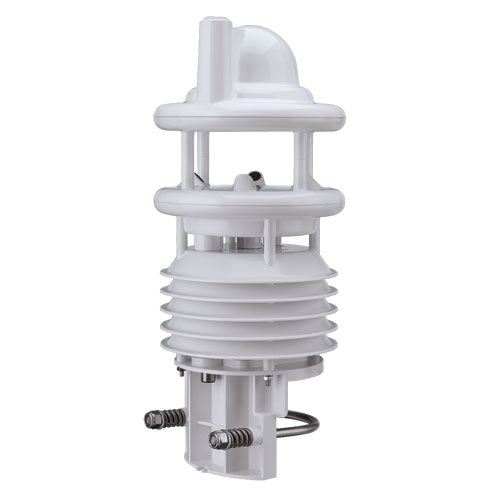Lufft WS800 Multi-Parameter Weather Sensor
The Lufft WS800 Multi-Parameter Weather Sensor simultaneously measures air temperature, humidity, pressure, precipitation, solar radiation, lightning & wind with an integrated electronic compass.
Features
- Integrated sensor analyzes radio wave emission of lightning events
- Easily mounts to 2" diameter pipe with integrated bracket mount & U-bolts
- SDI-12 output for integration with NexSens and other data loggers
Details
Overview
The Lufft WS800 Multi-Parameter Weather Sensor simultaneously measures air temperature, humidity, pressure, precipitation, solar radiation, lightning & wind with an integrated electronic compass.
Air Temperature & Humidity
Temperature is measured using a highly accurate NTC-resistor, while humidity is measured using a capacitive humidity sensor. Both sensors are located in a ventilated radiation shield to reduce the effects of solar radiation.
Pressure
Absolute air pressure is measured using a built-in MEMS sensor. The relative air pressure referenced to sea level is calculated using the barometric formula with the aid of the local altitude, which is user-configurable on the equipment.
Wind Speed & Direction
The wind sensor uses four ultrasound sensors which take cyclical measurements in all directions. The resulting wind speed and direction are calculated from the measured run-time sound differential.
Compass
The integrated electronic compass can be used to check the north-south adjustment of the sensor housing for wind direction measurement. It is also used to calculate the compass-corrected wind direction.
Precipitation
Tried and tested radar technology is used to measure precipitation. The precipitation sensor works with a 24GHz Doppler radar, which measures the drop speed and calculates precipitation quantity and type by correlating drop size and speed.
Solar Radiation
The pyranometer is intended for shortwave global solar radiation measurements in the spectral range from 300 to 1100nm. The thermopile sensor construction measures the solar energy that is received from the total solar spectrum and the whole hemisphere. The output is expressed in Watts per square meter.
Lightning Detection
Lightning detection is measured by an integrated sensor analyzing the radio wave emission of lightning, delivering a count of recognized lightning events. The sensor analyzes the spectrum and waveform of the received signal to suppress the detection of manmade electrical discharges.

